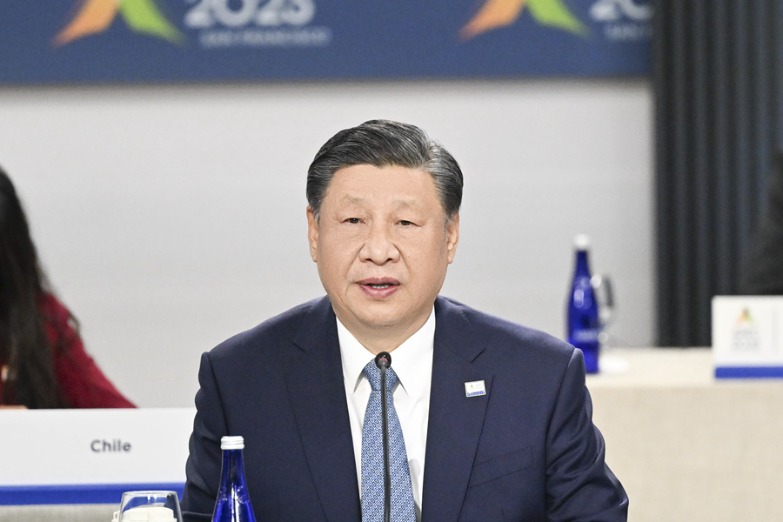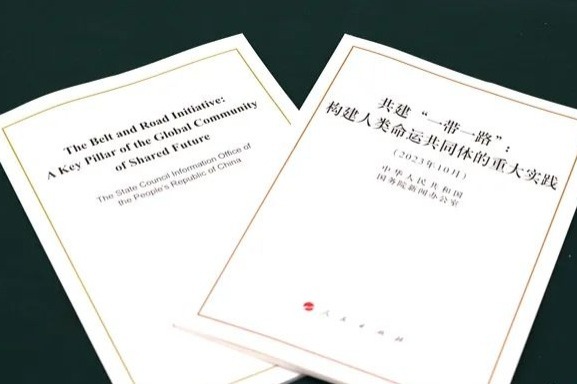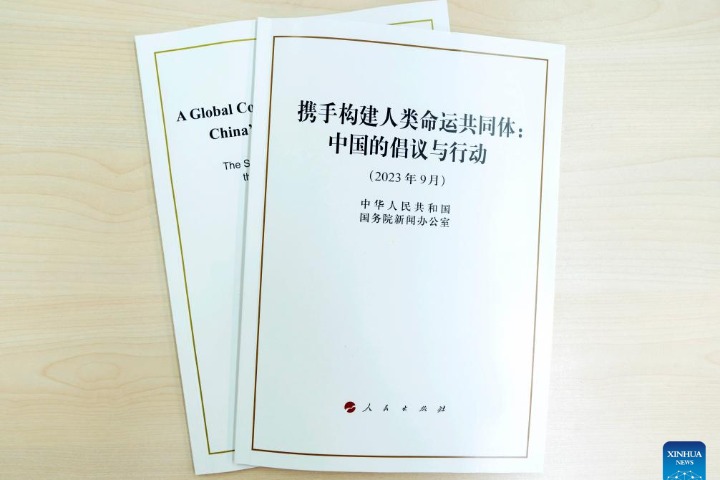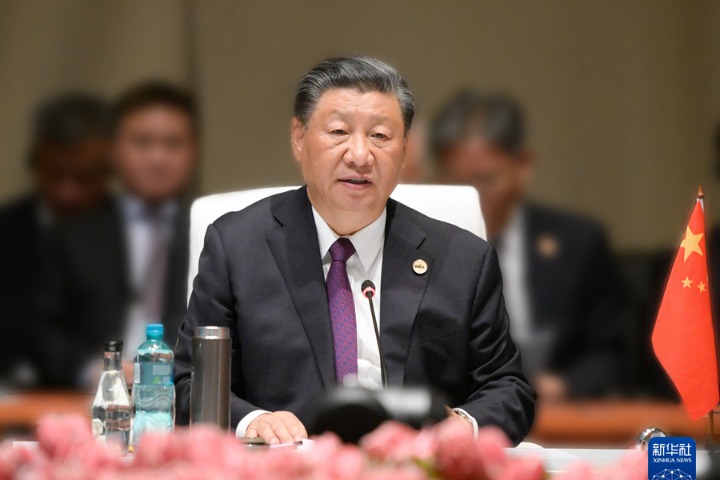新疆的若干历史问题(双语全文)
新华网 2019-07-22 09:19

三、新疆各民族是中华民族的组成部分
III. The Ethnic Groups in Xinjiang Are Part of the Chinese Nation
中华民族的形成与发展,是中原各族和文化同周边诸族和文化连续不断交往交流交融的历史过程。先秦时期的华夏族群,经过长期与周围族群的多元融合,特别是经过春秋战国500余年大动荡的交汇与融合,至秦汉之际,进一步与周围族群融合为一体,形成以中原人口居多的汉族,并从此成为中国历史进程的主体民族。魏晋南北朝时期,各民族尤其是北方少数民族向中原大迁徙,出现了大融合的局面。13世纪元朝建立,规模空前的政治统一局面推动了规模空前的民族迁徙,形成了元朝境内广泛的民族杂居局面。中华各民族在长期发展中,最终形成大杂居、小聚居的分布特点。多民族是中国的一大特色,各民族共同开发了祖国的锦绣河山、广袤疆域,共同创造了悠久的中国历史、灿烂的中华文化。
Historically, the Chinese nation was formed and developed through cultural communication, exchanges and integration between peoples in the Central Plains and in other regions. The Huaxia people who appeared in the pre-Qin period, after years of integration with various other peoples, and especially after 500 turbulent years of cultural convergence in the Spring and Autumn and Warring States periods, further integrated with other peoples in the Qin and Han dynasties to form the Han people, a majority group in the Central Plains and the major people in Chinese history. In the period of the Wei, Jin, and Northern and Southern Dynasties, different peoples, especially the northern ethnic minorities, migrated on a large scale to the Central Plains, resulting in further ethnic merging. In the 13th century, with the founding of the Yuan Dynasty, an unprecedented level of political unification gave rise to unprecedented ethnic migration, leading to various ethnic groups living together within the Yuan territories. After this long historical process, different ethnic groups of China eventually settled among each other, with compact communities here and there. Multiethnicity is a prominent feature of China. Together, the ethnic groups of China have explored the country’s rich resources and vast territories, and have created a long history and a splendid culture.
新疆地区自古就同中原地区保持着密切联系。早在商代,中原同西域就有玉石贸易。汉代张骞“凿空西域”打通丝绸之路,使者相望于道,商旅不绝于途。唐代“绢马互市”持续繁盛,“参天可汗大道”直通内地,沿途驿站星罗棋布,成为西域先民同中原密切联系的纽带。于阗乐、高昌乐、胡旋舞等西域乐舞深入宫廷,长安城流行西域风。出自今新疆库车的龟兹乐享誉中原,成为隋唐至宋代宫廷燕乐的重要组成部分。近代以来,在中华民族面临生死存亡的危急关头,新疆各族人民同全国人民一道,奋起反抗、共赴国难,共同谱写了可歌可泣的爱国主义篇章。新中国成立以来,新疆各民族关系进入平等、团结、互助、和谐的新时期。
Xinjiang has been in close contact with the Central Plains since ancient times. As early as the Shang Dynasty, the Western Regions traded jade with the Central Plains. In the Han Dynasty, imperial envoy Zhang Qian opened up the Silk Road, along which emissaries and merchants traveled. In the Tang Dynasty, merchants from the Central Plains and the Western Regions traded silk and horses, and a grand thoroughfare connected the Western Regions directly to Chang’an, the Tang capital, with courier stations along the way. Music and dances from Khotan, Gaochang and other places in the Western Regions were performed in the Tang court, and the exotic cultures of the Western Regions were popular in Chang’an. The music of Qiuci (today’s Kucha, Xinjiang) enjoyed great fame in the Central Plains, and became an important component of court music in the Sui, Tang and Song dynasties. In modern times, at critical junctures of the Chinese nation, the ethnic peoples in Xinjiang have fought alongside the rest of the country with great patriotism. Since the founding of the PRC, ethnic relations in Xinjiang have entered a new era characterized by equality, solidarity, mutual help, and harmony.
新疆自古以来就是多民族聚居地区。最早开发新疆地区的是先秦至秦汉时期生活在天山南北的塞人、月氏人、乌孙人、羌人、龟兹人、焉耆人、于阗人、疏勒人、莎车人、楼兰人、车师人,以及匈奴人、汉人等。魏晋南北朝时期的鲜卑、柔然、高车、嚈哒、吐谷浑,隋唐时期的突厥、吐蕃、回纥,宋辽金时期的契丹,元明清时期的蒙古、女真、党项、哈萨克、柯尔克孜、满、锡伯、达斡尔、回、乌孜别克、塔塔尔族等,每个历史时期都有包括汉族在内的不同民族的大量人口进出新疆地区,带来了不同的生产技术、文化观念、风俗习惯,在交流融合中促进经济社会发展,他们是新疆地区的共同开拓者。至19世纪末,已有维吾尔、汉、哈萨克、蒙古、回、柯尔克孜、满、锡伯、塔吉克、达斡尔、乌孜别克、塔塔尔、俄罗斯等13个主要民族定居新疆,形成维吾尔族人口居多、多民族聚居分布的格局。各民族在新疆地区经过诞育、分化、交融,形成了血浓于水、休戚与共的关系。各民族都为开发、建设、保卫新疆作出了重要贡献,都是新疆的主人。目前,新疆共生活着56个民族,是中国民族成分最全的省级行政区之一。其中,超过100万人口的有维吾尔族、汉族、哈萨克族和回族4个民族,超过10万人口的有柯尔克孜族、蒙古族2个民族。新疆地区既是新疆各民族的家园,也是中华民族共同家园的组成部分。
Xinjiang has been a multiethnic region since ancient times. The earliest explorers of Xinjiang included the Sai, Rouzhi, Wusun, Qiang, Qiuci, Yanqi, Khotan, Shule, Shache, Loulan and Cheshi peoples living in the Tianshan Mountains and the Xiongnu and Han peoples in the pre-Qin, Qin and Han dynasties. Following them were peoples of the Han, the Xianbei, Rouran, Gaoche, Yeda, and Tuyuhun in the period of the Wei, Jin, and Northern and Southern Dynasties; of the Turk, Tubo, and Ouigour in the period of the Sui and Tang dynasties; of the Khitan in the period of the Song, Liao, and Jin dynasties; of the Mongol, Jurchen, Dangxiang (Tangut), Kazak, Kirgiz, Manchu, Xibe, Daur, Hui, Uzbek, and Tatar in the period of the Yuan, Ming and Qing dynasties. Large numbers of various ethnic groups entering Xinjiang in different periods brought technology, culture and ideas, folk customs, and many other aspects of their lives into the region, promoting economic and social development through exchanges and integration. They were all explorers of Xinjiang. By the end of the 19th century, 13 ethnic groups – the Uygur, Han, Kazak, Mongol, Hui, Kirgiz, Manchu, Xibe, Tajik, Daur, Uzbek, Tatar, and Russian – had settled in Xinjiang, with the Uygurs having the largest population. Ethnic groups had grown, developed and integrated with each other despite periods of isolations and conflict, and shared good fortune and hardship in a close relationship. All of them have made important contribution to exploring, developing and protecting Xinjiang, and they are all masters of Xinjiang. Currently inhabited by 56 ethnic groups, Xinjiang is one of the provincial-level administrative regions with the most ethnic groups in China. The Uygur, Han, Kazak and Hui have populations of one million and above, and the Kirgiz and Mongol have populations exceeding 100,000. Today, Xinjiang, home to various ethnic groups, is an integral part of the Chinese nation.
新疆地区民族关系的演变,始终和中华各民族关系演变相联系。各民族有隔阂冲突更有交流融合,团结凝聚、共同奋进始终是主流。包括新疆各民族在内的中华各民族,分布上交错杂居,经济上相互依存,文化上兼收并蓄,情感上相互亲近,形成你中有我、我中有你、谁也离不开谁的多元一体格局,是一个大家庭里不同成员的关系。在中华民族大家庭中,新疆各民族手足相亲、守望相助,休戚相关、荣辱与共,共同生产生活,抵御外来侵略,反对民族分裂,维护祖国统一。
The evolution of ethnic relations in Xinjiang has always been linked to that between all ethnic groups in China. There have been periods of isolation and conflict, but exchange and integration, and unity and joint effort have always been the prevailing trend. The ethnic groups of China, including those in Xinjiang, live together alongside each other. They are economically interdependent and embrace each other’s culture, and are a unified whole that has become impossible to separate. They are members of the same big family. In this family of the Chinese nation, the ethnic groups in Xinjiang are like brothers and sisters who work and live together and help each other out. They have guarded against foreign aggression, opposed separatist activities, and safeguarded national unification.
四、维吾尔族是经过长期迁徙融合形成的
IV. The Uygur Ethnic Group Formed Through a Long Process of Migration and Integration
维吾尔族先民的主体是隋唐时期的回纥人,活动在蒙古高原,曾经有乌护、乌纥、袁纥、韦纥、回纥等多种汉译名称。回纥人为了反抗突厥的压迫和奴役,联合铁勒诸部中的仆固、同罗等部组成了回纥部落联盟。744年,统一了回纥各部的首领骨力裴罗受唐朝册封。788年,回纥统治者上书唐朝,自请改为“回鹘”。840年,回鹘汗国被黠戛斯攻破,回鹘人除一部分迁入内地同汉人融合外,其余分为3支:一支迁往吐鲁番盆地和今天的吉木萨尔地区,建立了高昌回鹘王国;一支迁往河西走廊,与当地诸族交往融合,形成裕固族;一支迁往帕米尔以西,后分布在中亚至今喀什一带,与葛逻禄、样磨等部族一起建立了喀喇汗王朝。回鹘人相继融合了吐鲁番盆地的汉人、塔里木盆地的焉耆人、龟兹人、于阗人、疏勒人等,构成近代维吾尔族的主体。元代,维吾尔族先民在汉语中又称畏兀儿。元明时期,新疆各民族进一步融合,蒙古人尤其是察合台汗国的蒙古人基本和畏兀儿人融为一体,为畏兀儿补充了新鲜血液。1934年,新疆省发布政府令,决定统一使用维吾尔作为汉文规范称谓,意为维护你我团结,首次精确表达了Uygur名称的本意。
The main ancestors of the Uygurs were the Ouigour people who lived on the Mongolian Plateau during the Sui and Tang dynasties. Many different names were used in historical records to refer to this group of people.
Historically, to resist oppression and slavery by the Turks, the Ouigour people united with some of the Tiele tribes to form the Ouigour tribal alliance. In 744, the Tang court conferred a title on Kutlug Bilge Khagan, who united the Ouigour tribes. In 788, the then Ouigour ruler wrote to the Tang emperor, requesting to have their name changed to “Uighur”. After the Uighur Khanate was defeated by the Kyrgyz people in 840, some of the Uighurs moved inland to live with the Han people, and the rest were divided into three sub-groups. One of the sub-groups moved to the Turpan Basin and the present-day Jimsar region, where they founded the Uighur Kingdom of Gaochang. Another moved to the Hexi Corridor, where they merged with local ethnic groups to become what was later known as the Yugurs. The third sub-group moved to the west of Pamir, scattered in areas from Central Asia to Kashgar, and joined the Karluk and Yagma peoples in founding the Kara-Khanid Khanate. There they merged with the Han people in the Turpan Basin and the Yanqi, Qiuci, Khotan, Shule, and other peoples in the Tarim Basin to form the main body of the modern Uygur ethnic group. In the Yuan and Ming dynasties, the various ethnic groups in Xinjiang further merged. The Mongols, especially those of the Chagatai Khanate, were fused with the Uighurs, adding fresh blood to the Uighur group. In 1934, Xinjiang issued a government order, stipulating that “维吾尔” would be the standard Chinese name for Uygurs, which for the first time expressed the accurate meaning of “Uygur”: to maintain unity among the people.
历史上,维吾尔族先民受突厥人奴役,两者是被奴役和奴役的关系。维吾尔族先民回纥早期受突厥统治,在唐朝军队支持下,起兵反抗东突厥汗国,并先后攻灭西突厥汗国、后突厥汗国。西突厥汗国灭亡后,一些使用突厥语族语言的部落向西迁徙,其中一支长期辗转西迁小亚细亚,融入当地诸族。维吾尔人不是突厥人的后裔。
The Ouigours endured slavery under the rule of the Turks. With support from Tang Dynasty troops, they rebelled against the Eastern Turkic Khaganate and defeated the Western Turkic Khaganate and the Second Turkic Khaganate. After the demise of the Western Turkic Khaganate, some Turkic-speaking tribes migrated westward. One of these tribes gradually settled down in Asia Minor, and integrated with local ethnic groups. The Uygurs are not descendants of the Turks.
近代以来,一些“泛突厥主义”分子以西迁的部分使用突厥语族语言的部落融入当地诸族为借口,把使用突厥语族语言的各民族都说成是突厥人,这是别有用心的。语族和民族是两个不同的概念,有着本质的区别。中国使用突厥语族语言的有维吾尔、哈萨克、柯尔克孜、乌孜别克、塔塔尔、裕固、撒拉等民族,他们都具有各自历史和文化特质,绝不是所谓“突厥族”的组成部分。
Since the modern times, some Pan-Turkism advocates with ulterior motives have described all peoples of the Turkic language family as “the Turks” using the untenable argument that the Turkic-speaking tribe integrated with the ancestors of the Turkish people after migrating westward. A language family and an ethnic group are two essentially different concepts. In China, ethnic groups speaking Turkic languages include the Uygurs, Kazaks, Kirgiz, Uzbeks, Tatars, Yugurs, and Salars, each with its own history and unique culture. These peoples cannot be referred to as “Turks”.

















 英语点津微信
英语点津微信 双语小程序
双语小程序